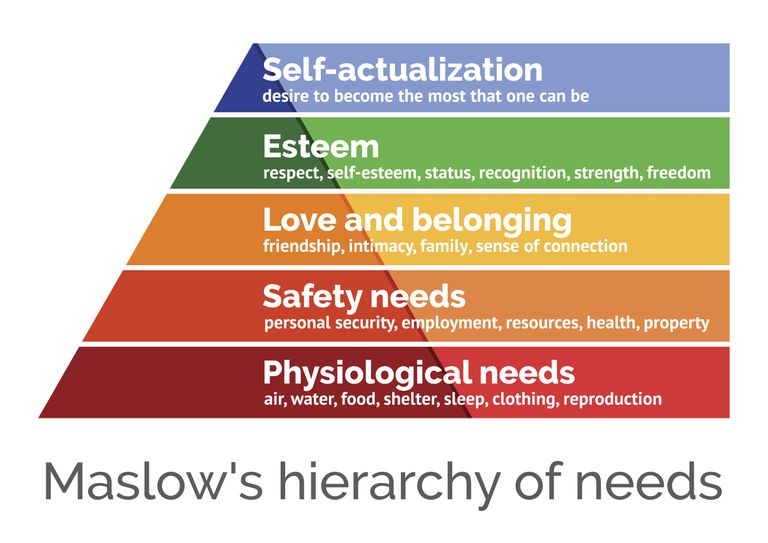Over time, the nature of drug addiction is such that it systematically disintegrates and destroys one’s basic functional abilities. This functional decline, however, can generally begin to be reversed once sobriety is achieved and one embarks on the path of recovery.1 One model that evidence has shown to be effective in the context of substance abuse and recovery is Maslow’s Hierarchy of Needs, a model shown to be efficacious for “psychological health and belief in internal control.” This blog will explore substance abuse, rehabilitation and recovery through the scope of Maslow’s Hierarchy of Needs, and how utilizing this model can be helpful for recovering addicts in conceptualizing and manifesting a successful recovery.
What is Maslow’s Hierarchy of Needs?

Maslow’s Hierarchy of Needs refers to Abraham Maslow’s psychological theory presented in his 1943 paper, “A Theory of Human Motivation,” published in Psychological Review. The theory offers to “a classification system which reflected the universal needs of society as its base and [proceeds] to more acquired emotions.” Maslow essentially designed a five-tier pyramid with the most basic human needs that must be met (e.g. the physiological needs of water, air, and food) at the bottom, before advancing further upward to our other human needs. Following the basic physiological needs for human survival, the next tier of the pyramid involves our need for safety (e.g. personal security, resources, employment, health, and property). Those of love and belonging (e.g. friendship, intimacy, and family) and esteem (e.g. self-respect, strength, freedom) follow the aforementioned safety needs. Finally, at the top of the pyramid is self-actualization—becoming the most that one can be by living out their fullest potential Now that we have a basic understanding of what Maslow’s model looks like, it is important to distinguish between deficiency needs and growth needs.
Deficiency Needs Versus Growth Needs
The needs projected in Maslow’s Hierarchy can be distinguished into two distinct subsets: deficiency needs and growth needs. The first four levels, or tiers, in Maslow’s pyramid can be classified, as deficiency needs. “Deficiency needs arise due to deprivation and are said to motivate people when they are unmet.” It is understood that the desire and motivation to meet these needs will grow stronger the longer they are denied (e.g. the desire for water becomes greater as one gets thirstier, as a physical example). The fifth tier of self-actualization, however, is considered a “growth need” and stems not from the lack of something, but rather, from the desire to develop and mature as an individual. These systems are in place to help us maneuver through life by developing appropriate coping mechanisms and evolve as a human being. Drug addiction, however, hijacks and disrupts this entire system. This is what makes recovery so difficult at first. Upon further investigation, we can begin to understand how this hierarchy of needs becomes modulated and usurped by consistent drug use and abuse.

An Imbalanced Decision Hierarchy in Drug & Alcohol Addicts Makes Early Recovery Especially Challenging
The fact of the matter is, most addicts eventually want to quit using drugs. However, “Despite explicitly wanting to quit, long-term addicts find themselves powerless to resist drugs, despite knowing that drug-taking may be a harmful course of action.”5 This cognitive dissonance “represents a cognitive/behavioral conflict that is a central characteristic of addiction.”5 Neurobiological changes and structural remodeling of brain structures make recovery an especially challenging endeavor.
“We admitted we were powerless over our addiction—that our lives had become unmanageable.”
This first and cornerstone tenant of Alcoholics and Narcotics Anonymous demonstrates just how pervasive and powerful that feeling of “helplessness” is among addicts in recovery. It is imperative to understand that science has firmly established this is not due to a moral failing! Instead, key neurological mechanisms geared toward survival have been hijacked and altered in fundamental ways that will require genuine perseverance and persistence to restore. A closer look at how addiction corrupts one’s rational thinking and cognitive processes may help better elucidate this concept.
How Addiction Corrupts Each Level in The Hierarchy of Needs
In active addiction, an individual may not be compelled or driven by the need for food, water, sex, connection, and especially, self-actualization, as their focus entirely shifts toward their drug of choice. As addiction progresses, one’s urge to get high usurps and overtakes every other basic need. Here’s how it affects every component in Maslow’s pyramid.
Drugs & Alcohol Overtake Basic Physiological Desires: Proper nutrition, hygiene, self-care, and general maintenance gets pushed to the wayside as even basic physiological desires are hijacked by the need to get high.
Safety: The need to feel “safe” so one can continue to use in peace may still be a priority for some—especially earlier on in their addiction. However, over time, as their addiction progresses to unhealthier levels, addicts may be willing to live on the street so they can continue using.
Money & Resources: The addict in question must develop a relationship with an individual who can provide them with their drug of choice as well as a source of income to finance their habit. Since the socioeconomic demographic of addicts spans the spectrum, this source of income may be a well-paying job, criminal activity, or even pawning items for cash.

Relationships: Normally, the next level would be building healthy friendships and relationships to help a person mature and flourish in life. However, those in active addiction may avoid loved ones and family, especially if the addict perceives such people to be a threat to their continued drug use. This is indeed one of many facts that makes addiction so challenging for the families and loved ones of addicts.
The Lack of “Self-Actualization” & The Constant Need for More: For the addict, there exists no desire for “self-actualization” and self-discovery. The need is solely to propagate and continue their drug use, undeterred and undisturbed. Consequences continue to pile up, but by this point, their sole focus exists solely to continue drug use until a drastic change takes place. Unfortunately, for many, all roads in addiction lead to the same three destinations: jails, institutions, and death.
The “Way Out” Is Difficult, But Not Impossible For Addicts

The aspects that make recovery from addiction so challenging, especially early on, are incredible discipline, drive, and the perseverance necessary in virtually every moment of every day. One must fight against their biology and reprogrammed neurophysiology, and change takes time. Given the powerful physiological effects of addiction, the base of the pyramid becomes unstable, with an external stimulus demanding the energy and resources that would normally help cater to the upper tiers of the pyramid, and therefore a person’s wellness. Without a stable place of balance and homeostasis, the pyramid—the life of the individual—begins to crumble. This can be difficult for friends and loved ones to witness, but it is exactly why support is so important. Without a guiding light affirming that a person can get better, it becomes increasingly difficult to take responsibility for one’s life and start from the proverbial ground up. Whether this light takes the form of a loving family member, a close friend, or even a powerful inner conscience, believing in oneself and humbly accepting one’s position is an important first step in developing the discipline necessary to reset one’s physiology to the healthy baseline required to achieve a sense of individual freedom—and reach a true expression of individuality.
If you, or a loved one, suffers from substance abuse, please reach out to our clinical team to set up a free consultation today at EvolveIndy.com

